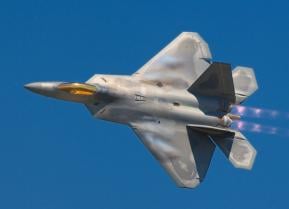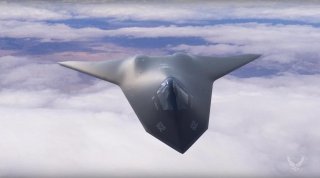Forget the F-22 or Su-57: Europe Wants a Deadly 6th Generation Stealth Fighter
But which nations will help build it?
So far, only the United States and China have successfully developed stealth aircraft, while credible efforts by Russia and Japan have stalled—at least for now. Thus, despite the difficulties of multinational cooperation, a pan-European project seems far more promising for the future of European military aviation—if the various players can get over some hefty political hurdles.
(This first appeared several months ago.)
On December 3, the Spanish Ministry of Defense announced its desire to join the Franco-German Future Combat Air System (FCAS) project to build a sixth-generation stealth fighter and an accompanying drone “wingman.” The initial Spanish buy-in is projected to amount to just twenty-five million euros over two years, but the document makes clear Madrid wants its industry to have a role in producing the next-generation fighters as well as procuring them to replace its older EF-18A Hornet fighters.
The Spanish announcement, however, also made revealing passing references to the United Kingdom’s similar Tempest stealth fighter program, which was unveiled in July 2018. Team Tempest was already partnered with Italian firm Leonardo for sensors and avionics, and the Spanish document claims the Netherlands is also involved in the British program.
Earlier, Spain had been weighing the benefits of joining Tempest versus FCAS. The Spanish Ministry of Defense stated it was “convinced” the two sixth-generation jet fighter programs would merge “given the huge investment required for their development.”
The FCAS project initially, and pointedly, made no mention of inviting British participation, likely due to Brexit. Since then, however, both Airbus and Dassault have sent positive signals regarding the Tempest project despite its status as a theoretical competitor.
In fact, one point of view is that the FCAS and Tempest programs may amount to an elaborate form of courtship, in which both multi-national programs coyly pretend disinterest in each other while seeking at every turn to make their projects more appealing and thus entice an eventual offer of cooperation.
The last few decades show that stealth fighter development and operation are both enormously expensive and prone to huge cost overruns, technical problems and even outright failure. Pooling together multiple partner nations could help split R&D costs and improve unit costs by creating economies of scale through larger procurements. This is why the UK, France, Germany and Italy have cooperated on past military jets like the Jaguar, Alpha Jet and the more modern Tornado and Typhoon.
But multinational programs have also been hampered by the need to compromise designs to fit competing national doctrines, capability requirements and domestic industrial interests. These considerations led France to duck out of both the Tornado and Typhoon in favor of her purely domestic Mirage 2000 and Rafale jets.
To be sure, the FCAS and Tempest concepts share a lot in common as they both aspire to incorporate a checklist of features expected of the still purely notional sixth-generation fighter, which is intended to be a leap ahead of today’s F-22, F-35 and J-20 stealth fighters. Common features include: stealthy airframes, powerful sensors designed to fuse with friendly forces (now including satellite assets), very long-range air-to-air missiles, laser or microwave weapons, ability to control friendly accompanying drones, optional manning (ability to fly without a human pilot onboard) and resilience versus cyberattacks.
Of course, the proposals, which truthfully are far from being set in stone, do have differences. FCAS properly refers to a combination of a manned next generation fighter with an unmanned “loyal wingman” type drone called the Next Generation Weapon System. (Hopefully the fetish for ultra-generic names will not last.) In October 2018, Dassault unveiled a tailless NGF mockup with W-shaped wings.
The twin-tailed Tempest proposal unveiled this July is “optionally-manned” and appears more detailed overall than FCAS, with specific provisions for adaptive-cycle Rolls-Royce turbofans, hypersonic weapons and computer-AIs to assist the pilot. However, neither program has specified much in terms of flight performance parameters.
Tempest and FCAS also appear to have different notional timelines, with production FCAS fighters expected in 2040 and Tempests due in 2035. Of course, at this early stage the successful completion of either project is far from assured.
One issue that looms over the two stealth fighter programs is Brexit, which spurred the Franco-German cooperation on FCAS in the first place, and makes cooperation with the UK awkward, particularly in the event of a no-deal Brexit. However, rather than being the bastions of chauvinistic nationalism one might expect, European militaries are often arguably more prone to multinational cooperation than their civilian governments, perhaps being keenly aware of limits to their capabilities outside of an alliance framework. However, this still leaves outstanding questions as to whether the EU will develop a “European Army” parallel to NATO—a stance which the UK has long opposed.
So far, only the United States and China have successfully developed stealth aircraft, while credible efforts by Russia and Japan have stalled—at least for now. Thus, despite the difficulties of multinational cooperation, a pan-European project seems far more promising for the future of European military aviation—if the various players can get over some hefty political hurdles.
Spain’s announcement shows both FCAS and Tempest are gathering mass and momentum and signals optimism that the differences can be bridged over—but of course, the message itself is also part of the diplomatic game.
Sébastien Roblin holds a master’s degree in conflict resolution from Georgetown University and served as a university instructor for the Peace Corps in China. He has also worked in education, editing, and refugee resettlement in France and the United States. He currently writes on security and military history for War Is Boring.


